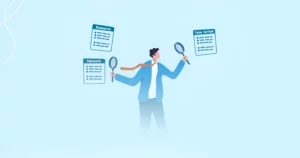For educators looking to pivot into the world of EdTech, the transition can feel daunting. You are passionate, highly skilled, and mission-driven, but navigating the job market may feel like a new language if you’ve never worked outside the classroom or district office.
Fortunately, AI can be a powerful tool in helping you bridge the gap. When used strategically, it doesn’t replace your effort—it multiplies it. Below are six AI-powered steps you can take to move from reflection to action and land a role in EdTech.
Step 1. Refine and Practice Your Personal Story
Before you update your résumé or scroll through job boards, get clear on your why. Why are you transitioning into EdTech? What strengths do you bring? What kind of impact are you hoping to make?
AI can help you shape your personal story into a coherent, relevant narrative—one you can use on your résumé, in interviews, or during networking conversations.
Example AI Prompt:
“Help me write a 2-minute personal story for an EdTech interview. I want to explain my background in education and why I’m transitioning.”
Having a compelling narrative makes the rest of your job search more focused and authentic.
Step 2. Decode Industry Jargon and Research Companies
Once you understand your story, start exploring where it might fit. The EdTech space is full of acronyms, SaaS models, and job titles that don’t exist in the classroom. AI can help decode these terms, summarize companies, and explain what different roles actually involve.
Example AI Prompt:
“What does this EdTech company do, and what kind of roles might be a good fit for someone with teaching experience?”
Researching first helps you avoid wasting time on misaligned roles and gives you language to better tailor your applications. To learn more about what roles exist in EdTech, check out our post “What Roles Exist at EdTech Companies?”
Note: While AI can be a powerful research assistant, it’s important not to take its responses at face value. Always double-check facts, verify sources, and use your own judgment to ensure the information about companies is accurate and relevant.
Step 3: Identify Skill Gaps and Build a Personalized Learning Plan
Once you’ve found a role that interests you, the next step is understanding how your current skills align and where there might be gaps. AI can help you identify both your strengths and your areas for growth with a targeted prompt. For example, try something like:
Example AI Prompt:
“I’m a middle school math teacher with 10 years of experience using data to drive instruction, mentoring new teachers, and leading department meetings. Here’s a job description for an EdTech Customer Success Manager. Can you help me identify which of my skills align with this role, and what skills I might need to develop?”
AI can quickly highlight transferable skills and help you see connections you may have missed. You might learn that your experience mentoring teachers aligns well with customer onboarding or that your department leadership translates into project management skills.
Once you’ve identified potential gaps, you can ask AI to recommend specific resources—like free online courses, tutorials, certifications, or professional communities—that align with the role you’re targeting. This saves hours of sifting through generic advice and helps you build a learning plan tailored to your actual goals.
You don’t need to become an expert overnight. Focus on making steady progress in a few high-impact areas that show initiative and relevance to your target role. The goal isn’t perfection; it’s momentum.
Step 4. Use AI to Tailor Your Résumé and Cover Letter for Each Job
Once you’ve identified a role that excites you, it’s time to tailor your résumé and cover letter to highlight the skills and experiences that matter most. This doesn’t mean copying and pasting a job description into your résumé. Instead, start by drafting your bullet points based on your real experience, then use AI to help you sharpen the language and ensure your message is clear and aligned with the role.
Example AI Prompt:
“Here’s my current résumé and a job description for an EdTech Customer Success Manager role. I’ve drafted the bullet points based on my real experience. Can you help me strengthen the language, improve clarity, and suggest edits that highlight how my background aligns with the role?”
You can also ask AI to review your cover letter for tone and structure, or to help you reframe your teaching experience using industry-relevant language. For example, classroom management might translate to stakeholder communication or project coordination. Just be sure that every word on your résumé reflects your actual experience—you want to stand out for the right reasons.
Recruiters can definitely tell if AI is used to fully write your résumé and cover letter. You should write the bulk of your resume and use AI to refine and edit it. It’s critical for you to review and fact-check AI’s work to ensure that all résumés you submit honestly reflect your experience.
Step 5. Draft Thoughtful Outreach Messages for Networking
AI can also support you in one of the most important (and often intimidating) parts of a career transition: networking. While it might be tempting to message recruiters or hiring managers directly, those messages are often ignored, especially if they’re asking for an interview or job. Instead, focus on building authentic connections with people who’ve walked a similar path or who are in roles that interest you.
Use AI to help you craft a concise, respectful outreach message tailored to your background and goals.
Example AI Prompt:
“Can you help me write a short LinkedIn message to a former teacher who now works as a Learning Experience Designer? I want to learn more about their transition and what the role is really like. I’m not asking for a job, just hoping to connect and hear about their experience.”
A well-crafted message can lead to valuable insights, referrals, or simply encouragement from someone who’s been where you are. And by using AI to help refine your message, you’ll be able to keep it clear, warm, and professional.
Over time, these conversations can give you a clearer picture of what different roles entail, what skills are most valuable, and what next steps might be worth exploring. Think of networking not as a means to a job, but as a way to learn, build relationships, and expand your understanding of what’s possible.
Step 6. Practice for Interviews with AI as Your Mock Interviewer
When the interviews start coming in, you want to be ready. AI can simulate mock interviews based on real job descriptions and even give you feedback on your responses.
Example AI Prompt:
“Pretend you’re an EdTech recruiter interviewing me for a Learning Experience Designer position. Ask me 5 behavioral questions based on this job description.”
Practicing with AI gives you a low-stakes way to get more confident, especially if you’re new to behavioral interview formats or corporate lingo. You can also use these same questions and answers to practice your interview skills with a friend.
Final Thought
Using AI doesn’t mean taking shortcuts. It means being intentional about how you tell your story, where you want to go, and how you prepare to get there. For educators making the leap into EdTech, these tools can offer clarity in a time of transition and a little extra momentum when you need it most.



